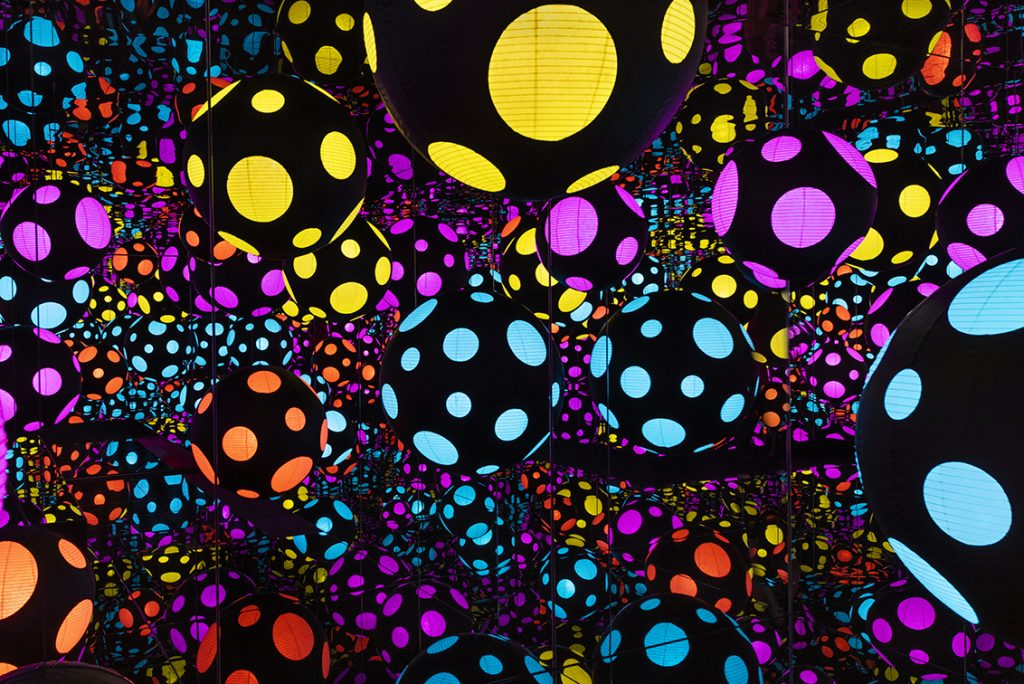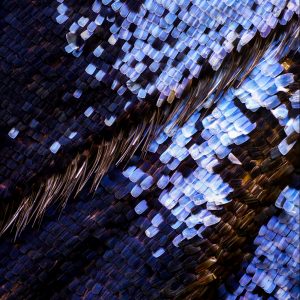Link About It: This Week’s Picks
O-faces around the globe, the image of a black hole, a font to improve memory and more

Butterfly Wings Explored Through Chris Perani’s Marco Photography

Layer upon layer of iridescent scales, running along multicolored hairs, are revealed through Chris Perani’s marco photography of butterfly wings. The photographer employs a 10x microscope objective affixed to a 200mm lens in order to get such precision. The findings are perhaps unsurprisingly exquisite and thoroughly mesmerizing, but Perani’s method is certainly notable. See more imagery at Colossal, where Perani outlines his process further.
Pierpaolo Piccioli’s Renaissance Painting-Inspired Collection for Moncler

For Italian luxury skiwear brand Moncler, Valentino’s acclaimed creative director Pierpaolo Piccioli has delivered a capsule collection that harks back to the forms of early-Renaissance paintings. The full-body, lightweight down-filled-nylon pieces—zip-up hooded capes, layered over padded skirts and paired with gloves—are out today. According to Piccioli, it’s “an uttermost expression of my taste and a very personal effort.” To exemplify the inspiration, textile designer and photographer Suzanne Jongmans released an art series that puts the pieces in classic frame. See more of the imagery at designboom.
Orgasm Faces Around the World
 According to a study published this week by Proceedings of the National Academy of Sciences, it seems orgasmic facial expressions vary depending on where in the world you’re from. When asked to decide which face was mid-climax, participants from Western cultures decided an orgasm looked more excited and outward (signified by an open mouth and wide-eyes) while Eastern participants believed that an orgasm looked like closed mouth smiles and gentle release. Read more about what their answers signify culturally on Ars Technica.
According to a study published this week by Proceedings of the National Academy of Sciences, it seems orgasmic facial expressions vary depending on where in the world you’re from. When asked to decide which face was mid-climax, participants from Western cultures decided an orgasm looked more excited and outward (signified by an open mouth and wide-eyes) while Eastern participants believed that an orgasm looked like closed mouth smiles and gentle release. Read more about what their answers signify culturally on Ars Technica.
Yayoi Kusama’s Work From a Different Angle
 Much of Yayoi Kusama‘s work draws inspiration from her lifelong hallucinations, obsessive-compulsive behavior and fears, with her narratives oftentimes firmly based around mental health. While the brilliant artist has, more recently, been reduced to and stereotyped as a “wacky” Japanese artist who makes installations that result in selfie mania, Kusama’s works and process are so much more. For World Mental Health Day this year, Jyni Ong at It’s Nice That explores Kusama’s work through a different lens. As Ong writes, “Yayoi’s immense creative output seems deeply therapeutic and intuitive to her sense of self-expression. However, there is also something to be said in how she uses her external expression of art as a means to further understand her inner-self.” Read more at It’s Nice That.
Much of Yayoi Kusama‘s work draws inspiration from her lifelong hallucinations, obsessive-compulsive behavior and fears, with her narratives oftentimes firmly based around mental health. While the brilliant artist has, more recently, been reduced to and stereotyped as a “wacky” Japanese artist who makes installations that result in selfie mania, Kusama’s works and process are so much more. For World Mental Health Day this year, Jyni Ong at It’s Nice That explores Kusama’s work through a different lens. As Ong writes, “Yayoi’s immense creative output seems deeply therapeutic and intuitive to her sense of self-expression. However, there is also something to be said in how she uses her external expression of art as a means to further understand her inner-self.” Read more at It’s Nice That.
The Only American Company Making Paper Straws
 Paper straws got a bad reputation as flimsy and funky-tasting, thanks in part to versions produced in China. But Fort Wayne, Indiana-based Aardvark returned to paper straw production in 2007, when demand required that they start up again (they invented the paper straw back in 1888). Not only are the products “green,” they’re also ideal to use. Much of the process behind them is secret, and the plant is close-doored, but a few things are known. First, the straws are sustainable—produced with paper sourced from trees Aardvark grows themselves. Second, demand is skyrocketing right now, according to David Rhodes, the company’s global business director. For those looking for plastic alternatives, this is one worth trying for yourself. Read more at Bloomberg.
Paper straws got a bad reputation as flimsy and funky-tasting, thanks in part to versions produced in China. But Fort Wayne, Indiana-based Aardvark returned to paper straw production in 2007, when demand required that they start up again (they invented the paper straw back in 1888). Not only are the products “green,” they’re also ideal to use. Much of the process behind them is secret, and the plant is close-doored, but a few things are known. First, the straws are sustainable—produced with paper sourced from trees Aardvark grows themselves. Second, demand is skyrocketing right now, according to David Rhodes, the company’s global business director. For those looking for plastic alternatives, this is one worth trying for yourself. Read more at Bloomberg.
Assembling an Image of the Shadow of a Black Hole

In a mind-boggling excerpt from Seth Fletcher’s book Einstein’s Shadow: A Black Hole, a Band of Astronomers, and the Quest to See the Unseeable (published by Ecco), the author probes the meticulous process behind the Event Horizon Telescope (EHT). In fact, a series of collaborative data sets collected in 2017 by eight telescopes around the planet, the EHT aims to create an image of the shadow of a black hole using vast amounts of cross-referenced and corroborated information. Fletcher’s insight and prose captivates as much the scientific developments, and the excerpt—published by the New York Times Magazine—frequently stuns with unimaginable facts.
Moog’s First Polysynth in 35 Years
 In a short film featuring Dev Hynes, Mark Ronson and Ryuichi Sakamoto, among others, Moog teased the release of its first polysynth in 35 years. The Moog One (available in eight-voice ($5,999) or 16-voice ($7,999) versions) features three VCOs, two independent analog filters and a revamped collection of native effects. Moog hopes the new additions will allow users to form “deeply layered, evolving soundscapes.” Read more about the release and the rest of Moog’s upcoming products at Fact.
In a short film featuring Dev Hynes, Mark Ronson and Ryuichi Sakamoto, among others, Moog teased the release of its first polysynth in 35 years. The Moog One (available in eight-voice ($5,999) or 16-voice ($7,999) versions) features three VCOs, two independent analog filters and a revamped collection of native effects. Moog hopes the new additions will allow users to form “deeply layered, evolving soundscapes.” Read more about the release and the rest of Moog’s upcoming products at Fact.
Long-Lost Eames Radio Design Realized
 Vitra is bringing a long-lost Eames design to life: a molded plywood framed radio. With holes for speakers and a few knobs for tuning, the device has been made in an edition of 999, with the first 50 available at the MoMA Design Store. The design was never realized during the ’40s, when it was initially drawn up, because the design was deemed “too modern.” Now, with the help of Vitra and the office’s current director (and the duo’s grandson), the design is for sale—with WiFi and bluetooth capabilities included. Read more at Fast Company.
Vitra is bringing a long-lost Eames design to life: a molded plywood framed radio. With holes for speakers and a few knobs for tuning, the device has been made in an edition of 999, with the first 50 available at the MoMA Design Store. The design was never realized during the ’40s, when it was initially drawn up, because the design was deemed “too modern.” Now, with the help of Vitra and the office’s current director (and the duo’s grandson), the design is for sale—with WiFi and bluetooth capabilities included. Read more at Fast Company.
This Font Might Improve Your Memory
 A new typeface—the result of a collaboration between RMIT University’s design school and its behavioral business lab—may increase the amount of information we retain from reading. Called Sans Forgetica, it was conceptualized for students cramming for big exams. With lots of backward slants and gaps, the type makes use of a design principle called “desirable difficulty” which slows the reader down, resulting in more retention and employs “deeper cognitive processing.” Read more at It’s Nice That.
A new typeface—the result of a collaboration between RMIT University’s design school and its behavioral business lab—may increase the amount of information we retain from reading. Called Sans Forgetica, it was conceptualized for students cramming for big exams. With lots of backward slants and gaps, the type makes use of a design principle called “desirable difficulty” which slows the reader down, resulting in more retention and employs “deeper cognitive processing.” Read more at It’s Nice That.
Link About It is our filtered look at the web, shared daily in Link and on social media, and rounded up every Saturday morning.












